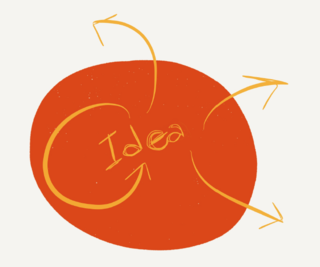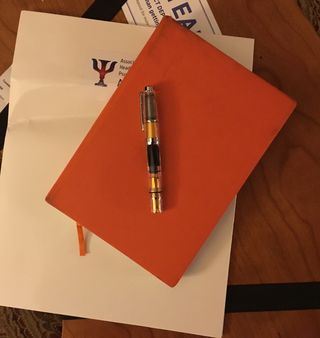Cognition
A Pretty Good Organizing System for Non-Linear Thinkers
Use non-linear thinking to keep yourself organized.
Posted November 15, 2017
With two kids and a husband who are ‘organizationally challenged’, I’ve written about organizational strategies before. Keeping organized reduces anxiety. If we try to keep everything in our head without an organizational system, we keep returning to things we know we have to remember. This increases our cognitive load and making us panicky. Writing things down is soothing (read Getting Things Done and Reduce Anxiety for some methods of doing that).
The key to any organizing system is using it. Unfortunately, most organizing systems are developed by linear thinkers: those students who begin each semester by writing down every assignment on their (perfectly neat) color-coded planner, update their to-do lists daily and have perfectly organized closets. I love those people; I have bonded with students over a shared love of fountain pens and animated discussions of the perfect type of notebook to use for different types of projects. But that's not who I am and that's not how I work.
I am an organized person, but I am not a linear thinker. My thinking tends to be grouped by projects, with one idea spinning off into five other directions. Opening a book to start writing a lecture reminds me that I need to pick up food for the chickens. Writing it gives me a new idea for a research project. I need an organizing system that allows me to channel the real strength of being able to make connections between ideas rather than trying to squeeze it into a linear mold.
If you’re like that, this system may work for you. It is built on three simple principles:
- Reward accomplishments
- Plan ahead
- Reduce cognitive load and anxiety
It requires two tools:
- A journal (any kind of notebook that you like carrying around)
- A calendar
You can do it electronically, but there are real advantages to using a paper journal. It slows you down and writing by hand activates different parts of our brains than working with a keyboard.

The Pretty Good System Step I: Write
The goal of the Pretty Good System is the same as every other system: to write down everything you have to do so you won’t forget things. Most systems start out by having you write down all the things you need to do—every single thing. It is overwhelming, cathartic sometimes, and always useful. But it’s depressing because my lists are never-ending and I never got everything on them done.
So let’s start with the fun stuff: reward!
Log your day. Open your journal. Write the date at the top. Then start to list everything you got done today. Revel in it.
This feels great! Don’t limit yourself. Don't dwell on all the thing you coulda/shoulda/woulda done. If you were really happy with the outfit you put together this morning, write that down. Celebrate that accomplishment! If that reminds you how you drove your daughter to school and she remembered to pack her own lunch and told you she loved you, write that down. The goal of this is just a mind dump; get it out on paper so you can look at it and make it a list. Lots of individual points that don't have to make sense to anyone but you.
Start a to-do list. While you’re writing all that down, I bet a lot of other stuff will come to mind. It does for me. I write down that I fed the chickens and it reminds me that they’re almost out of food and I need to buy some more. Excellent! That’s part of what writing things down does for you; it reminds you of other things relating to what you’re writing down. On the left side of the page (I always write my log on the right page of my journal), I start jotting down the things I remembered I need to do.
Update your calendar. I will also be reminded of other things I need to remember that are time specific. I’ll remember that I set up an appointment with a student or that I have a chapter due Saturday. That why I keep my calendar handy while I’m writing down what I’ve gotten done. Anything time specific, I write down there. I'll also check my calendar for things related to what I did today and to see how much time I'll have to do things tomorrow.
Do short tasks now. The other type of thing that comes up when I keep my log is a bunch of dumb little tasks that will take around two minutes each to do. Why do I say two minutes? Because in David Allen’s excellent book Getting Things Done, he argues that if you have a job that will take less than two minutes to complete, you should just do it as soon as you think about it. Why? Because it takes longer to write it down and remember to do it later than do it. Plus it's going to hang over your head until you do, with all the anxiety that causes. So if writing down that I gave a lecture on ANOVAs reminds me that I need to set up a meeting with a student, I’ll shoot off that email right then and there; it never makes it to my to-do list and I don't have to think about it again.
Jot down good ideas. Finally, logging can remind me of good ideas that I had or help me makes connections I hadn't made before. I'll either jot them into my log or, better still, flip the page and jot them down on a clean page to think about later.
Recap: What have I done?
- I wrote a list of everything I finished and all the highlights of my day.
- I generated a list of tasks I need to do in the future
- I updated my calendar
- I got a bunch of small hanging things out of the way
- I jotted down a good idea or two
This probably took me 15 minutes. (15 minutes unless I got sucked into my email or an online computer search—something it takes discipline to avoid. This is another reason to write by hand and just use a keyboard for calendar and short tasks.)
The Pretty Good System Step Two: Review
Organizers work when people use them and when they review them. In other words, writing things down is a necessary but not sufficient step to being organized. Like taking notes, the key is not in the writing, it is in the processing.
The second step of the Pretty Good System is to glance over the last few days of your journal. Celebrate once more that your son got a B on his paper and that you finally sent out that report you’ve been working on. But also look over the last few to-do lists and see if there’s anything on them that should be added to today.
Having done that, take a few seconds to just highlight what is most important to really get done tomorrow and maybe an aspirational project you want to make some headway on. Be realistic: I’m happy to knock two or three things off my list. This doesn't mean I'm not getting stuff done, but new things I didn't anticipate come up. The goal is to keep on swimming, not to win Olympic gold.
Some Tips and Tricks
Using an organizer is about keeping your life together, not about spending your life making your organizer look like it's up for a graphic design award. (Bullet journals can be spectacularly beautiful but that's a hobby, not a tool.) There are, however, things that can make the basic Pretty Good System work even better.
Buy a notebook. You could use the Pretty Good System on scraps of paper, but I like having a notebook that I can carry around with me. In fact, I like having a nice inexpensive journal that's easy to see on my desk to carry around with me. The advantage of using a notebook is that it allows you to look back on things. If you have one that is easy to spot and you like, you'll use it more often.

As I say, I tend to keep my "log" on the right side of the pages, and my "to-do" on the left so I can see both lists at the same time and don't have to flip pages. I personally like to use grid paper to keep lists because everything lines up. You may like plain paper better.
Write By Hand. As I said earlier, there are real advantages using a paper rather than an electronic journal. Keyboards push you into a linear mindset. The thing about the Good Enough System is that it lets you surf the flow of your fluid mind.
I don't think the format of the calendar matters (I use an electronic one myself). However, if you want the best of both worlds, you can photograph your journal and import the pictures into an electronic notebook like OneNote or EverNote. They will even scan your handwriting and turn it into searchable text. If you search online, you will even find paper journals that are made to be imported directly into electronic systems.
Finding things. I stole two important ideas from the bullet journal people: using symbols and building an index.
As I said above, I use my journal to keep track of lots of things besides my "log" and "to-do" lists. I use it for anything I want to find later: notes for a demo I’m going to do or thoughts on what I want to do for class next week. I don’t keep this stuff organized in any particular place, I just start at the front of the notebook and use the next free page to write down the next idea I have. In other words, my logs, to-do list and other miscellaneous things are just mixed together in my journal in the order they happen. (Bonus: this is much less expensive because I don't waste money on half-empty journals with partially filled sections I never used.)
To find things, I use bookmarking symbols and an index. Both of these systems allow me to go with my naturally fluid, non-linear thinking, but actually find things again when I want them without wasting a lot of time.
- Bookmarking Symbols: On all my log pages, I scribble in the top right-hand corner of the page with a triangle. Why? Because when I flip through my book, all the dark corners stand out. Simple.
- More symbols: I have some other symbols; I draw little squares on the side of pages having to do with my work as department chair. I color in the bottom corner of pages having to do with research ideas. Same simple idea: the symbols stand out so it reduces my search pattern when I'm flipping through my Journal. If I know when I wrote it down and I know what it was about, it’s not that hard to find. Don't use too many. Most of the time you'll have a pretty good idea when an idea came up and all your log entries have dates on them. That really limits where you need to look.
- Indexes: Developing an index is a lot easier than it sounds. I leave the first few pages of my journal blank. I number all the pages in my journal. When I write down something important that I know I’ll want to find later, I go to my index page. I write down the page number and what it is that I’ll need to remember. When I want it later, I just have to look down the list on the Index page instead of hunting through the whole book. Easy.
Try it. It’s 15 minutes at the end of the day. It feels pretty good. It works pretty well too.
(c) Nancy Darling, 2017




